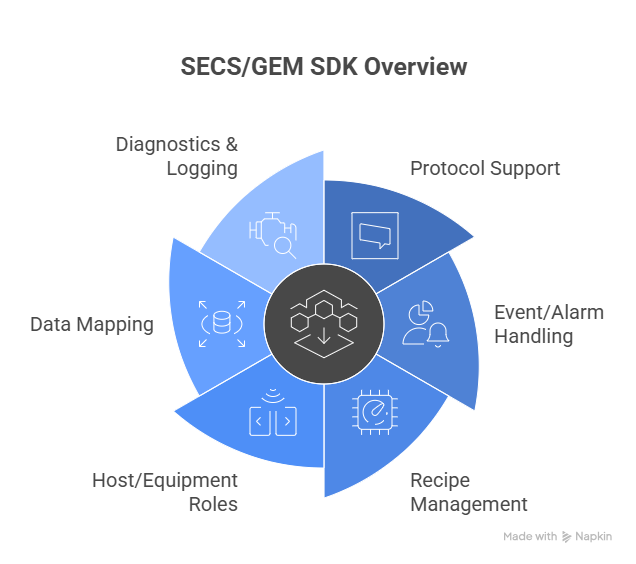Introduction
In the fast-paced world of semiconductor manufacturing, seamless communication between equipment and factory systems is essential. Standards such as SECS-II and GEM (SEMI E30) define how semiconductor tools interact with hosts, enabling automation, recipe control, and equipment monitoring. However, implementing these standards from scratch can be complex and time-consuming. This is where a SECS/GEM SDK comes into play.
A SECS GEM software development kit provides developers with ready-to-use libraries, APIs, and tools that simplify the integration process. By leveraging a SECS GEM integration SDK, factories can accelerate automation projects, ensure compliance with SEMI standards, and improve equipment-to-host connectivity. This blog explores how a SECS GEM API bridges the gap between equipment and factory systems, and why it is a cornerstone of modern semiconductor automation.

Understanding the SECS/GEM SDK
A SECS/GEM SDK is more than just a coding toolkit—it is a complete solution for building applications that conform to SEMI E5 (SECS-II), E30 (GEM), and E37 (HSMS-SS) standards. Instead of manually coding protocol layers, developers can rely on the SDK’s SECS/GEM communication library to handle low-level messaging.
The SECS/GEM protocol SDK typically includes host and equipment simulators, message builders, and debugging tools. This makes it easier to test SECS/GEM equipment connectivity before deployment in a fab. By reducing development time and ensuring standard compliance, an SDK streamlines the path to automation and operational excellence.
Benefits for Factory Systems
The biggest advantage of a SECS GEM integration SDK is its ability to improve factory-wide automation. By standardizing SECS/GEM host communication, fabs gain reliable data exchange between equipment and MES. This enables real-time decision-making, predictive maintenance, and yield optimization.
Additionally, a robust SECS GEM driver ensures equipment can be connected seamlessly to new or legacy systems. For fabs moving toward cloud adoption, SDKs often support SECS/GEM interface software that bridges equipment with modern analytics platforms. In short, SDKs reduce integration friction and maximize factory automation ROI.
Key Features of SECS/GEM SDKs
Modern SECS GEM software development kits are designed with flexibility and scalability in mind. Some of their most important features include:
Protocol Support: Full compliance with SECS-I, HSMS-SS, and SECS-II messaging.
Event and Alarm Handling: Subscribing to CEIDs, SVIDs, and alarms for monitoring.
Recipe Management: Uploading and downloading PPIDs through the SECS GEM API.
Host and Equipment Roles: Acting as both a GEM host or GEM equipment simulator.
Data Conversion: Mapping SECS messages into formats like JSON or XML for integration with MES and cloud systems.
For developers, these features are packaged into a SECS GEM development toolkit, which ensures that every project can be executed efficiently without compromising SEMI compliance.
How SECS/GEM SDKs Support Integration Workflows
A typical integration workflow using a SECS GEM protocol implementation involves several steps:
Configuration: Define SVIDs, CEIDs, and alarms using SDK utilities.
Connection Setup: Establish HSMS-SS sessions for equipment communication.
Application Development: Use SECS GEM API calls to manage data, recipes, and alarms.
Testing: Validate connections with host and equipment simulators included in the SECS/GEM protocol SDK.
Deployment: Connect to MES, data historians, or cloud systems for full-scale operation.
This streamlined approach highlights how a SECS GEM development toolkit reduces complexity, ensuring that factory integration projects are both reliable and scalable.

Future of SECS/GEM SDKs
The semiconductor industry is moving toward hybrid automation that combines traditional GEM with newer standards like Interface A (SEMI EDA). A flexible SECS/GEM SDK will play a key role in bridging these worlds. With support for cloud-native protocols and data streaming, the SECS GEM software development kit is evolving into a gateway for AI-driven analytics and predictive manufacturing.
Future-ready SDKs will continue to expand, offering enhanced SECS/GEM equipment connectivity while simplifying integration with IoT platforms and edge gateways. As fabs modernize, the SECS GEM integration SDK will remain a foundation for ensuring interoperability between diverse systems.
Conclusion
A SECS/GEM SDK is the critical bridge between semiconductor equipment and factory systems. With prebuilt libraries, APIs, and simulators, the SECS GEM software development kit reduces complexity and accelerates integration. From enabling SECS/GEM host communication to supporting cloud-based architectures, these toolkits empower fabs to unlock higher levels of automation and efficiency.
By leveraging a reliable SECS GEM integration SDK and its SECS GEM API, manufacturers can ensure smooth SECS/GEM equipment connectivity, future-proof their operations, and maintain compliance with SEMI standards. As the industry continues to evolve, the SECS GEM development toolkit will remain a cornerstone of semiconductor automation, bridging the gap between equipment and factory systems.

